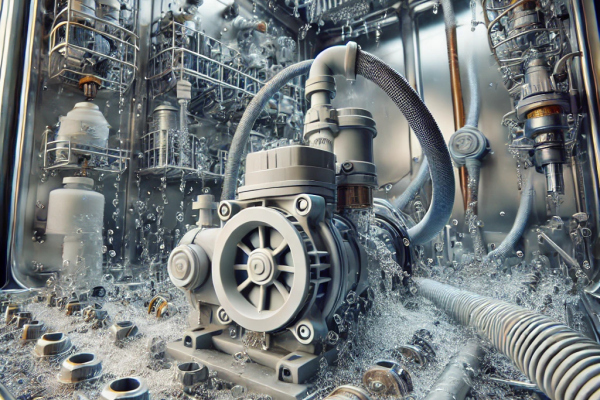
Why Your Dishwasher Isn’t Draining: Expert Tips from Texas
Dishwashers have become an indispensable part of modern homes, easing daily chores and saving valuable time. However, like any appliance, they can encounter problems. One of the most common issues is when a dishwasher fails to drain water. In Texas, where the hot climate and specific conditions can affect household appliances, understanding the causes of this malfunction and how to fix it becomes especially important for homeowners.
1. Problems with the Water Tap or Water Supply
Insufficient water pressure or issues with the water tap can hinder the normal operation of a dishwasher, including the draining process. In Texas, where water supply can be unstable due to droughts or extreme weather conditions, such problems are more frequent.
Tip:
Check if the water tap is fully open and if an adequate amount of water is flowing into the machine. Open the tap and ensure that water flows smoothly without interruptions. If you notice a drop in water pressure, the issue might be related to the overall water supply in your area. In this case, contact your local water utility service or check with neighbors to see if they are experiencing similar problems. Sometimes, simply cleaning the faucet aerator can restore normal water pressure.
2. Clogged Drain Filter
A clogged drain filter is one of the most common reasons why a dishwasher doesn’t drain. The filter traps food remnants and other small particles, preventing them from entering the drainage system. Over time, the filter can become blocked, hindering the normal flow of water.
Tip:
Regularly clean the drain filter by removing the lower rack of the dishwasher and taking out the filter. Rinse it under running water, removing all visible debris. In Texas, where dishwashers are often used with high-temperature water, filters can become dirty more quickly. Clean the filter at least once a month, especially if you use the dishwasher frequently.
3. Clogged Drain Hose
The drain hose connects the dishwasher to the sewage system. A clogged hose can be caused by the buildup of grease, food remnants, or other deposits. In Texas, where water may contain more minerals than in other regions, such clogs occur more often.
Tip:
Inspect the drain hose for blockages by disconnecting the dishwasher from the power supply and water source. Remove the hose and rinse it under running water. Use a flexible brush to remove stubborn debris, and check the hose for cracks or damage that could lead to leaks or more serious issues.
4. Contaminated Pump Filter
The pump filter helps prevent debris from clogging the drain pump. If this filter becomes contaminated, it can impede water drainage. In Texas, where dishwashers operate at high temperatures, fats and oils solidify more quickly, making clogging problems worse.
Tip:
Regularly clean the pump filter by removing visible debris. Locate the pump, usually found at the bottom of the machine beneath the filter. Use a brush or cloth to gently remove accumulated particles. This ensures the pump functions optimally and helps prevent further clogs.
5. Problems with the Drain Pump
The drain pump is responsible for expelling water from the dishwasher. If the pump is damaged or blocked, water cannot leave the machine. In Texas, where extreme temperatures can affect electrical components, pumps may fail more frequently.
Tip:
Check the drain pump for any foreign objects, such as glass shards or small fragments. If the pump makes unusual noises or doesn’t operate at all, it may need to be replaced. In Texas, qualified specialists are available to assist with pump repairs or replacements. Regular maintenance can help identify issues early and prevent costly repairs.
6. Faulty Electronic Components
Modern dishwashers are equipped with electronic control systems that regulate various functions, including water drainage. A malfunction in these systems can cause the dishwasher to fail to drain water. In the hot Texas climate, electronic components may be subjected to additional stress, increasing the risk of failure.
Tip:
If you suspect a problem with the electronic components, contact a professional technician. In Texas, numerous service centers specialize in diagnosing and repairing dishwasher electronics. A technician can quickly identify the malfunction and perform repairs using original parts and modern tools.
7. Incorrect Dishwasher Installation
Mistakes during the installation of a dishwasher can lead to drainage issues. Incorrect hose angle or insufficient distance from the sewage system can cause water to flow back. In older homes in Texas, where plumbing systems might be outdated, such errors become particularly critical.
Tip:
Ensure that the hose is installed at the correct angle and maintains the necessary distance from the sewage system. Follow the manufacturer’s installation instructions carefully. If you are unsure, it is advisable to call a professional to inspect and adjust the installation. Proper installation not only prevents drainage problems but also ensures long-term machine efficiency.
8. Worn-Out Machine Parts
Over time, some parts of the dishwasher can wear out, affecting its overall performance, including the draining process. In conditions of constant use and high temperatures, as in Texas, parts wear out more quickly.
Tip:
Perform regular maintenance on your dishwasher. Pay attention to the condition of belts, pumps, and other mechanical components. If you notice wear and tear, replace the damaged parts promptly to avoid serious malfunctions. Regular maintenance not only extends the machine’s lifespan but also ensures its reliable operation.
Preventive Measures to Avoid Drainage Problems
To prevent drainage issues in your dishwasher, follow these simple yet effective preventive measures:
- Regular Cleaning of Filters and Pumps: This helps prevent the buildup of debris and clogs.
- Use of Quality Detergents: Avoid using harsh chemicals that can damage the machine’s components.
- Avoid Overloading the Machine: Overloading can lead to food residue accumulation and clogs.
- Check the Condition of Hoses and Connections: Regularly inspect hoses for cracks or wear.
- Use Dishwasher Salt: In areas with hard water, using specialized salt helps prevent limescale buildup.
- Periodic Cleaning Cycles: Many dishwashers have self-cleaning programs that should be used regularly.
When to Call Professionals
If the drainage issue persists after following these steps, it may be time to consult a professional plumber. In Texas, specialized companies offer repair and maintenance services for household appliances, including dishwashers.
Advantages of Consulting Professionals:
- Time and Effort Savings: Professionals can quickly and efficiently resolve the issue.
- Quality Assurance: Technicians use original parts and guarantee the quality of their work.
- Advice and Recommendations: Professionals provide tips on usage and maintenance.
- Safety: Working with electrical and plumbing components requires specialized knowledge and tools.
Conclusion
Drainage problems in a dishwasher can be caused by various factors, ranging from simple clogs to complex electronic malfunctions. Understanding the main causes and knowing how to address them can help you restore your appliance’s functionality and avoid significant breakdowns. In Texas, where household appliances are subjected to additional stress, regular maintenance and timely consultation with specialists are crucial.
By performing regular maintenance, using quality detergents, and following installation instructions, you can keep your dishwasher running smoothly for many years. If problems persist, don’t hesitate to consult professionals who can resolve the issue quickly and efficiently, ensuring that your dishwasher continues to serve you well.






